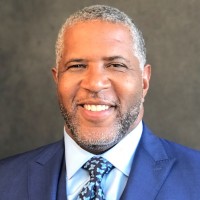Key Takeaways:
- STEM stands for science, technology, engineering and mathematics, and those fields encompass several other disciplines, such as chemistry.
- STEM education offers the practical experience and STEM skills students need to succeed in the STEM workforce and related fields.
- Access to STEM education leads to career opportunities in fields, such as software, information technology, space exploration, artificial intelligence and more.
From the study of the natural world to creating prototypes for new innovations, STEM is a cutting-edge field that enhances our knowledge of humankind, society and the universe beyond. STEM education helps students land jobs at top tech startups and government agencies. And it expands opportunities for these students past the STEM fields because of the skills gained through the STEM learning approach.
Below, we dive into the basics of what STEM stands for and the different subjects that make up STEM. We also discuss how the subjects housed in the STEM sector are intertwined, STEM v.s. STEAM, STEM education and how STEM helps address crucial global issues.
What Is STEM?
STEM stands for science, technology, engineering and mathematics and encompasses a wide range of studies and professions within numerous industries.
STEM instruction is hands-on and offers students the opportunity to learn and employ real-world applications and design-based challenges in and outside the classroom. Additionally, STEM provides students with much-needed life and professional development skills, including collaboration, communication, problem-solving and critical, analytical and proactive thinking.
What Are the STEM Fields?
Science
Science is a STEM discipline based on the scientific method, theory and law — and integrates research, observation, experimentation and documenting information and findings of the physical world. Other aspects of science are induction, critical analysis and testing. The subject of science encapsulates earth sciences, physical sciences and social sciences, such as anthropology.
Famous scientists include Sir Issac Newton, Ada Lovelace, Louis Pasteur, Katherine Johnson, George Washington Carver and Neil deGrasse Tyson. Conservationists, forensic scientists and chemists are all examples of science careers.
Technology
Technology is vastly intertwined with the human experience and is used to help move society forward. The power of technology helps enhance homes, educational institutions and workplaces. Artificial intelligence, cell phones, medical diagnostics and GPS are all types of technology. In the workplace, enterprise software technology, for example, can shift how organizations function as businesses and how companies improve day-to-day operations.
Technology inventors include Jaap Haartsen, the innovator behind Bluetooth® wireless technology, and Marian Croak, who conceived VoIP or Voice over Internet Protocol technology.
Engineering
Engineering embraces math, science and technology in its framework, altering the way we live, including designing and improving infrastructure and safety measures. Engineers research, develop, model, design and test, in and outside an office setting. There are four main types of engineering: electrical engineering, chemical engineering, mechanical engineering and civil engineering. Other classes of engineering are industrial engineering, biomedical engineering, aerospace engineering and nuclear engineering.
Past and present famous engineers are Nikola Tesla, Thomas Edison, Steve Wozniak, Alice Parker and George Westinghouse Jr.
Mathematics
Mathematics is a science – and the discipline has evolved from studying shapes and enumeration to adopting the practice of such concepts as order and structure. Mathematics is divided into several branches of study, including geometry, algebra, trigonometry, statistics and number theory. Another branch of mathematics, calculus, was founded by Gottfried Leibniz and Isaac Newton in the 17th century.
This STEM field offers many career opportunities, such as financial planner, accountant, data scientist and cost estimator, that require analytical and quantitative reasoning, critical thinking, research and numeracy skills.
Notable mathematicians across history include Alan Turing, Thomas Bayes, Blaise Pascal and Pierre-Simon Laplace.


Get Industry leading insights from Robert F. Smith directly in your LinkedIn feed.
Get Industry leading insights from Robert F. Smith directly in your LinkedIn feed.
What Is STEM Education?
STEM education is a type of multidisciplinary curriculum that integrates science, technology, engineering and mathematics into a practical, hands-on learning approach. STEM curriculum is often taught through at-home activities, after-school programs, summer camps and in K-12 classrooms across the U.S. STEM education is important because it teaches beneficial skills, such as leadership, that transfer into life and a future career.
What Is a STEM Major?
A STEM major in higher education is one that focuses on the areas noted above. College STEM majors can earn a STEM degree in the following areas of study:
- Food technology and processing
- Urban forestry
- Artificial intelligence
- Civil engineering
- Computer science
- Molecular biology
- Zoology
- Pharmacology
- Robotics
- Web development
However, this list is by no means exhaustive, and there are hundreds of other STEM majors. Majoring in these STEM subjects can lead to a myriad of STEM careers. A few top options include financial analyst, software developer, information technology (IT) manager, astronaut, augmented reality architect, data scientist and aerospace engineer.
Those in a STEM major can also expect a potentially fruitful career. According to the U.S. Bureau of Labor Statistics, as of 2022, STEM occupations have a median salary of $97,980. The Bureau also projected that from 2014 to 2024, careers related to mathematics would be the fastest-growing STEM occupations.
STEM vs. STEAM
STEM education offers abundant opportunities for students. Over the years, this curriculum has expanded and can sometimes include the arts. This acronym is known as STEAM. STEAM education curriculum includes music, dance, visual arts and language arts and incorporates building soft skills to enhance problem-solving skills. STEAM education fosters collaboration and innovation — and uses arts knowledge to help students grasp the concepts of science, technology, engineering and mathematics.
Integrating art into STEM programs and implementing it in real-world applications has been viewed and valued as a stepping stone for STEM student achievements, particularly for those from underrepresented backgrounds. Applying art to STEM education also motivates students to take risks, offers a more comprehensive learning experience and provides accessibility to students who may feel a STEM career is out of reach. STEAM education helps students with creativity, resourcefulness and nurtures an inventive mind.
Upon receiving a bachelor’s degree or other higher education degree, STEAM scholars may work in video game design, app design, archeology, medical illustration, urban planning and sound engineering.
The Interconnected Nature of STEM
STEM’s interdisciplinary teaching model can help boost proficiency and knowledge in a multitude of areas, leading to success in future careers. For example, STEM can link the fields of science and technology to business and entrepreneurship through research and development initiatives for products. Or, someone who works in business may need to be aware of different sectors of the organization, such as communications and technology, to help the business grow.
Learning both technical and soft skills is crucial in many career paths, and are often taught as part of the STEM curriculum. Careers that require STEM and business skills include insurance underwriters, computer systems managers, survey researchers, financial managers and project managers.
Looking Ahead: The Future of STEM
STEM is rapidly progressing — moving society toward a different tomorrow. Current and emerging trends in STEM include AI and machine learning, space exploration, climate science and renewable energy. The technologies and innovations that result from these STEM sectors are working to change lives and communities across the globe.
Looking at present and forthcoming methods of STEM education, equity, justice and advocacy are becoming more ingrained as approaches in STEM curricula — and can assist in creating solutions for parity and civic and global challenges.However, a lack of diversity and representation of people from underserved backgrounds still exists among STEM workers. In 2021, only 18% of STEM careers were held by women, and only 18% of STEM jobs were held Black Americans.
The future looks bright for STEM professionals. STEM will continue to expand its curriculum and enhance job opportunities for those interested in these interdisciplinary fields.
Stay up to date with the latest from entrepreneur and dealmaker Robert F. Smith, a former STEM major and voice for underserved communities, by following him on LinkedIn.






